Treasury Risk Management Research Report on ANZ Bank, BAO5572, 2019
VerifiedAdded on 2023/03/23
|8
|1603
|44
Report
AI Summary
This report provides an analysis of treasury and risk management at the Australian and New Zealand Banking Group Limited (ANZ). It identifies the role of the treasurer within the context of the 2017 global corporate treasury survey and highlights two significant treasury risk management issues based on the firm's nature, size, and responsibilities. The report details potential risks in managing these treasury issues, examines current risk management practices, and discusses the outcomes of these techniques. It also touches upon ANZ's performance, prospects, and valuation, referencing the bank's position as one of Australia's 'big four' and its past recognition as a sustainable bank. The competitive landscape, including threats from new entrants, substitute products, buyer and supplier power, and rivalry among firms, is also considered. The report concludes by addressing the importance of efficient treasury functions and information management for effective risk mitigation.
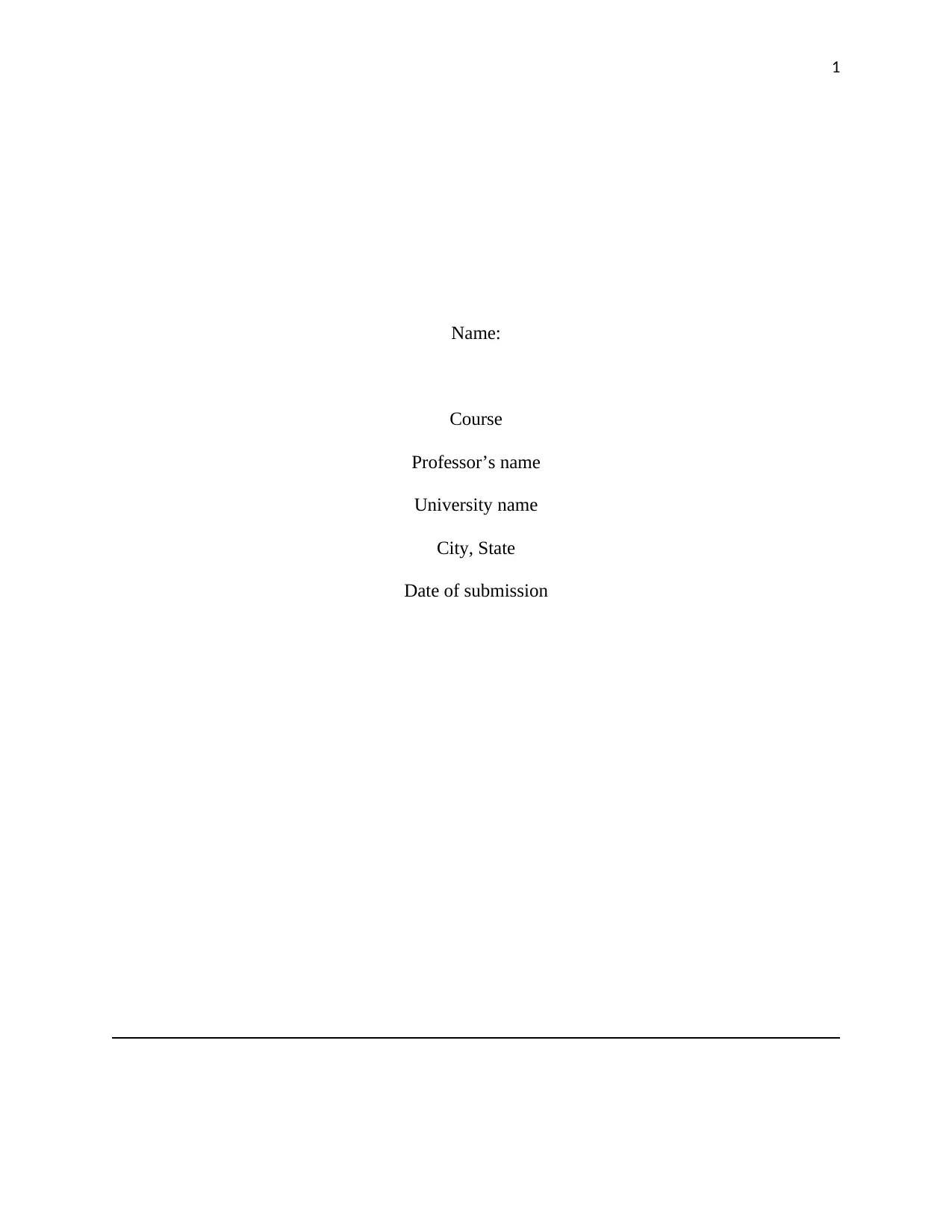
1
Name:
Course
Professor’s name
University name
City, State
Date of submission
Name:
Course
Professor’s name
University name
City, State
Date of submission
Paraphrase This Document
Need a fresh take? Get an instant paraphrase of this document with our AI Paraphraser
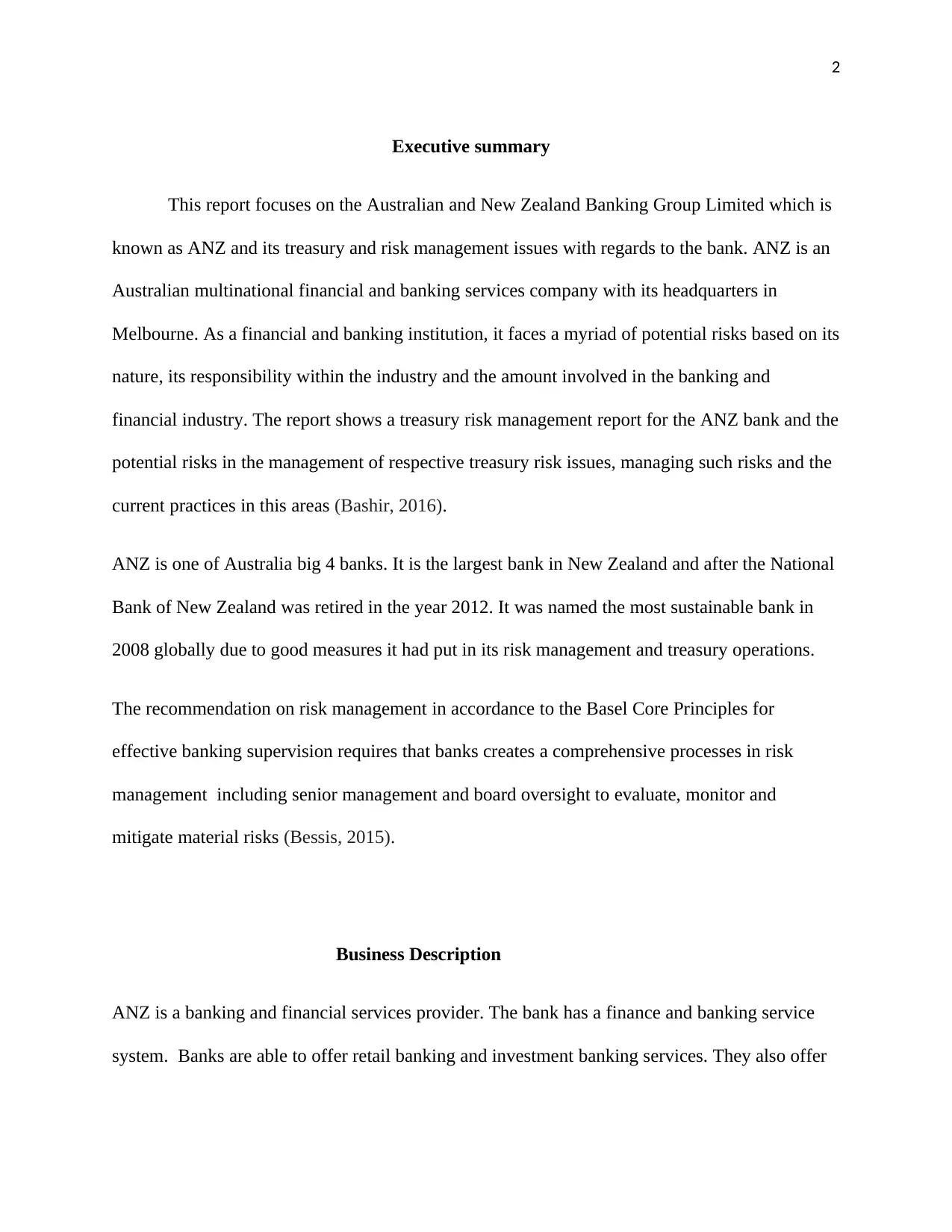
2
Executive summary
This report focuses on the Australian and New Zealand Banking Group Limited which is
known as ANZ and its treasury and risk management issues with regards to the bank. ANZ is an
Australian multinational financial and banking services company with its headquarters in
Melbourne. As a financial and banking institution, it faces a myriad of potential risks based on its
nature, its responsibility within the industry and the amount involved in the banking and
financial industry. The report shows a treasury risk management report for the ANZ bank and the
potential risks in the management of respective treasury risk issues, managing such risks and the
current practices in this areas (Bashir, 2016).
ANZ is one of Australia big 4 banks. It is the largest bank in New Zealand and after the National
Bank of New Zealand was retired in the year 2012. It was named the most sustainable bank in
2008 globally due to good measures it had put in its risk management and treasury operations.
The recommendation on risk management in accordance to the Basel Core Principles for
effective banking supervision requires that banks creates a comprehensive processes in risk
management including senior management and board oversight to evaluate, monitor and
mitigate material risks (Bessis, 2015).
Business Description
ANZ is a banking and financial services provider. The bank has a finance and banking service
system. Banks are able to offer retail banking and investment banking services. They also offer
Executive summary
This report focuses on the Australian and New Zealand Banking Group Limited which is
known as ANZ and its treasury and risk management issues with regards to the bank. ANZ is an
Australian multinational financial and banking services company with its headquarters in
Melbourne. As a financial and banking institution, it faces a myriad of potential risks based on its
nature, its responsibility within the industry and the amount involved in the banking and
financial industry. The report shows a treasury risk management report for the ANZ bank and the
potential risks in the management of respective treasury risk issues, managing such risks and the
current practices in this areas (Bashir, 2016).
ANZ is one of Australia big 4 banks. It is the largest bank in New Zealand and after the National
Bank of New Zealand was retired in the year 2012. It was named the most sustainable bank in
2008 globally due to good measures it had put in its risk management and treasury operations.
The recommendation on risk management in accordance to the Basel Core Principles for
effective banking supervision requires that banks creates a comprehensive processes in risk
management including senior management and board oversight to evaluate, monitor and
mitigate material risks (Bessis, 2015).
Business Description
ANZ is a banking and financial services provider. The bank has a finance and banking service
system. Banks are able to offer retail banking and investment banking services. They also offer
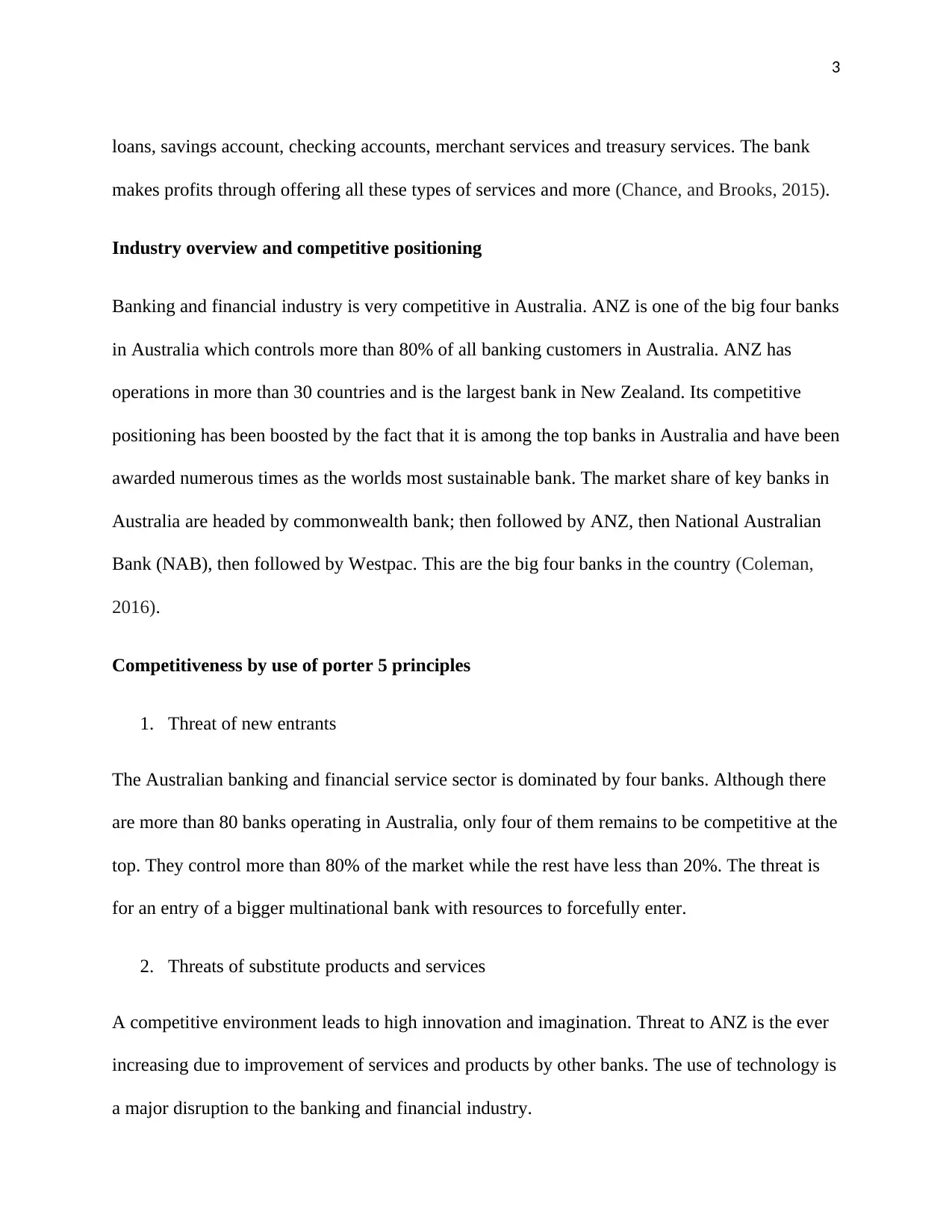
3
loans, savings account, checking accounts, merchant services and treasury services. The bank
makes profits through offering all these types of services and more (Chance, and Brooks, 2015).
Industry overview and competitive positioning
Banking and financial industry is very competitive in Australia. ANZ is one of the big four banks
in Australia which controls more than 80% of all banking customers in Australia. ANZ has
operations in more than 30 countries and is the largest bank in New Zealand. Its competitive
positioning has been boosted by the fact that it is among the top banks in Australia and have been
awarded numerous times as the worlds most sustainable bank. The market share of key banks in
Australia are headed by commonwealth bank; then followed by ANZ, then National Australian
Bank (NAB), then followed by Westpac. This are the big four banks in the country (Coleman,
2016).
Competitiveness by use of porter 5 principles
1. Threat of new entrants
The Australian banking and financial service sector is dominated by four banks. Although there
are more than 80 banks operating in Australia, only four of them remains to be competitive at the
top. They control more than 80% of the market while the rest have less than 20%. The threat is
for an entry of a bigger multinational bank with resources to forcefully enter.
2. Threats of substitute products and services
A competitive environment leads to high innovation and imagination. Threat to ANZ is the ever
increasing due to improvement of services and products by other banks. The use of technology is
a major disruption to the banking and financial industry.
loans, savings account, checking accounts, merchant services and treasury services. The bank
makes profits through offering all these types of services and more (Chance, and Brooks, 2015).
Industry overview and competitive positioning
Banking and financial industry is very competitive in Australia. ANZ is one of the big four banks
in Australia which controls more than 80% of all banking customers in Australia. ANZ has
operations in more than 30 countries and is the largest bank in New Zealand. Its competitive
positioning has been boosted by the fact that it is among the top banks in Australia and have been
awarded numerous times as the worlds most sustainable bank. The market share of key banks in
Australia are headed by commonwealth bank; then followed by ANZ, then National Australian
Bank (NAB), then followed by Westpac. This are the big four banks in the country (Coleman,
2016).
Competitiveness by use of porter 5 principles
1. Threat of new entrants
The Australian banking and financial service sector is dominated by four banks. Although there
are more than 80 banks operating in Australia, only four of them remains to be competitive at the
top. They control more than 80% of the market while the rest have less than 20%. The threat is
for an entry of a bigger multinational bank with resources to forcefully enter.
2. Threats of substitute products and services
A competitive environment leads to high innovation and imagination. Threat to ANZ is the ever
increasing due to improvement of services and products by other banks. The use of technology is
a major disruption to the banking and financial industry.
⊘ This is a preview!⊘
Do you want full access?
Subscribe today to unlock all pages.

Trusted by 1+ million students worldwide
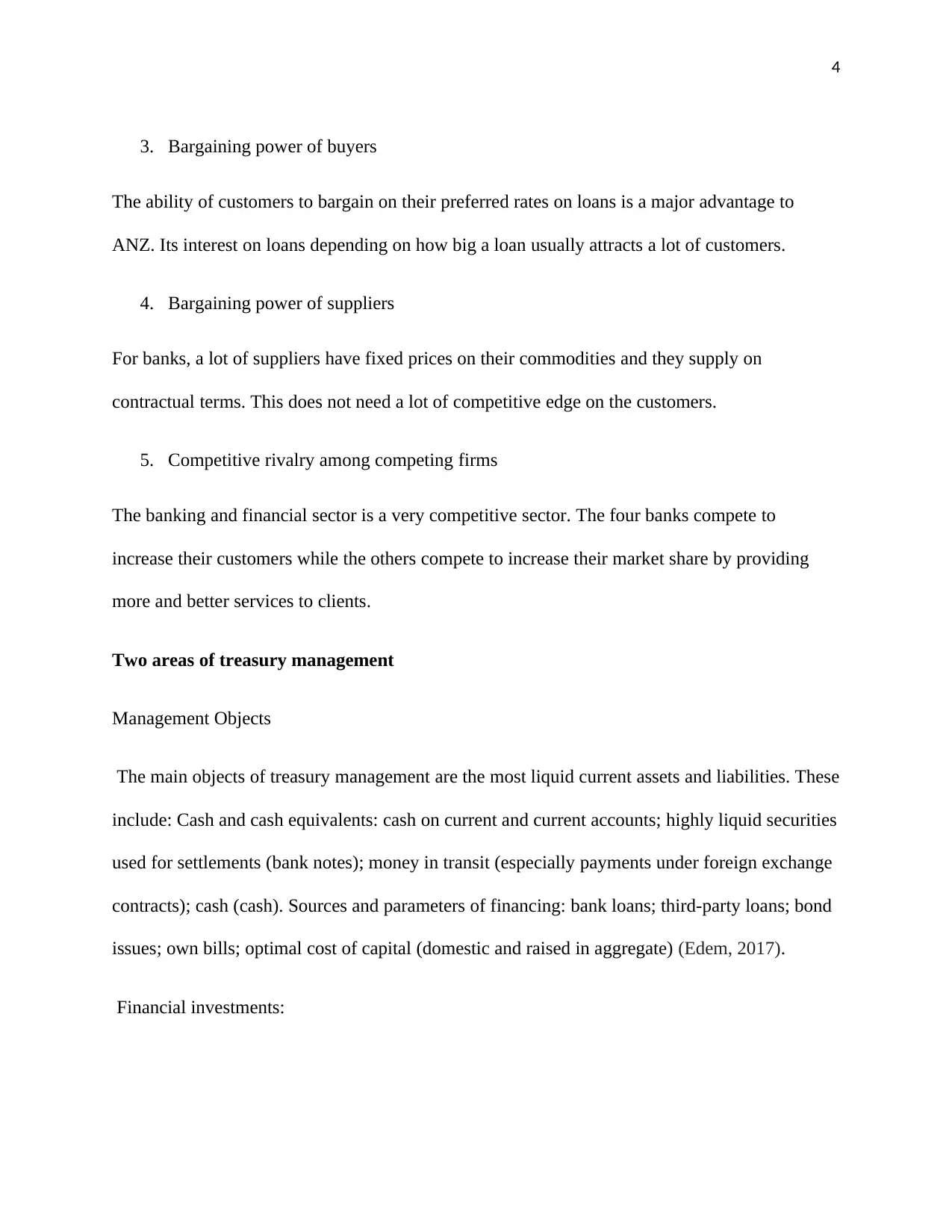
4
3. Bargaining power of buyers
The ability of customers to bargain on their preferred rates on loans is a major advantage to
ANZ. Its interest on loans depending on how big a loan usually attracts a lot of customers.
4. Bargaining power of suppliers
For banks, a lot of suppliers have fixed prices on their commodities and they supply on
contractual terms. This does not need a lot of competitive edge on the customers.
5. Competitive rivalry among competing firms
The banking and financial sector is a very competitive sector. The four banks compete to
increase their customers while the others compete to increase their market share by providing
more and better services to clients.
Two areas of treasury management
Management Objects
The main objects of treasury management are the most liquid current assets and liabilities. These
include: Cash and cash equivalents: cash on current and current accounts; highly liquid securities
used for settlements (bank notes); money in transit (especially payments under foreign exchange
contracts); cash (cash). Sources and parameters of financing: bank loans; third-party loans; bond
issues; own bills; optimal cost of capital (domestic and raised in aggregate) (Edem, 2017).
Financial investments:
3. Bargaining power of buyers
The ability of customers to bargain on their preferred rates on loans is a major advantage to
ANZ. Its interest on loans depending on how big a loan usually attracts a lot of customers.
4. Bargaining power of suppliers
For banks, a lot of suppliers have fixed prices on their commodities and they supply on
contractual terms. This does not need a lot of competitive edge on the customers.
5. Competitive rivalry among competing firms
The banking and financial sector is a very competitive sector. The four banks compete to
increase their customers while the others compete to increase their market share by providing
more and better services to clients.
Two areas of treasury management
Management Objects
The main objects of treasury management are the most liquid current assets and liabilities. These
include: Cash and cash equivalents: cash on current and current accounts; highly liquid securities
used for settlements (bank notes); money in transit (especially payments under foreign exchange
contracts); cash (cash). Sources and parameters of financing: bank loans; third-party loans; bond
issues; own bills; optimal cost of capital (domestic and raised in aggregate) (Edem, 2017).
Financial investments:
Paraphrase This Document
Need a fresh take? Get an instant paraphrase of this document with our AI Paraphraser
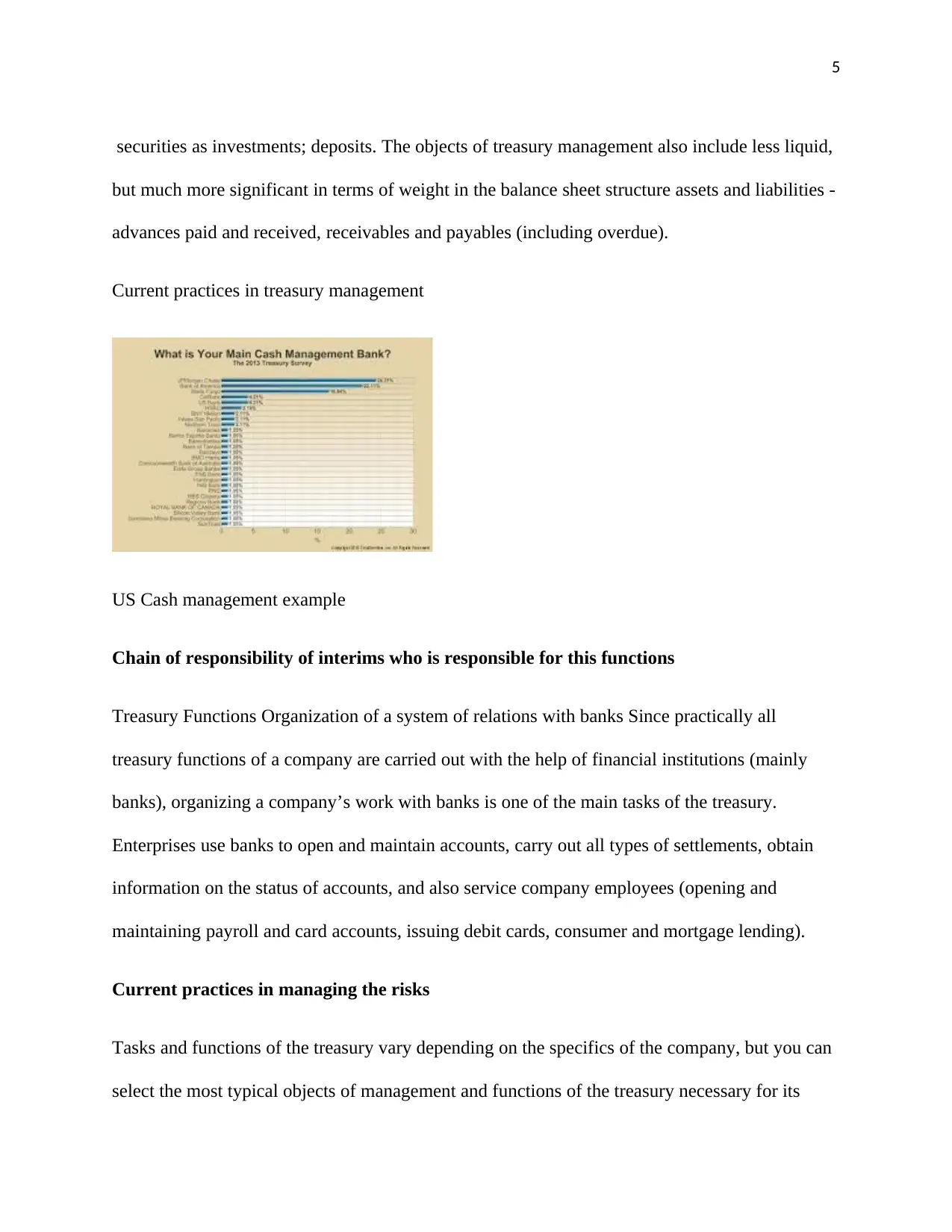
5
securities as investments; deposits. The objects of treasury management also include less liquid,
but much more significant in terms of weight in the balance sheet structure assets and liabilities -
advances paid and received, receivables and payables (including overdue).
Current practices in treasury management
US Cash management example
Chain of responsibility of interims who is responsible for this functions
Treasury Functions Organization of a system of relations with banks Since practically all
treasury functions of a company are carried out with the help of financial institutions (mainly
banks), organizing a company’s work with banks is one of the main tasks of the treasury.
Enterprises use banks to open and maintain accounts, carry out all types of settlements, obtain
information on the status of accounts, and also service company employees (opening and
maintaining payroll and card accounts, issuing debit cards, consumer and mortgage lending).
Current practices in managing the risks
Tasks and functions of the treasury vary depending on the specifics of the company, but you can
select the most typical objects of management and functions of the treasury necessary for its
securities as investments; deposits. The objects of treasury management also include less liquid,
but much more significant in terms of weight in the balance sheet structure assets and liabilities -
advances paid and received, receivables and payables (including overdue).
Current practices in treasury management
US Cash management example
Chain of responsibility of interims who is responsible for this functions
Treasury Functions Organization of a system of relations with banks Since practically all
treasury functions of a company are carried out with the help of financial institutions (mainly
banks), organizing a company’s work with banks is one of the main tasks of the treasury.
Enterprises use banks to open and maintain accounts, carry out all types of settlements, obtain
information on the status of accounts, and also service company employees (opening and
maintaining payroll and card accounts, issuing debit cards, consumer and mortgage lending).
Current practices in managing the risks
Tasks and functions of the treasury vary depending on the specifics of the company, but you can
select the most typical objects of management and functions of the treasury necessary for its
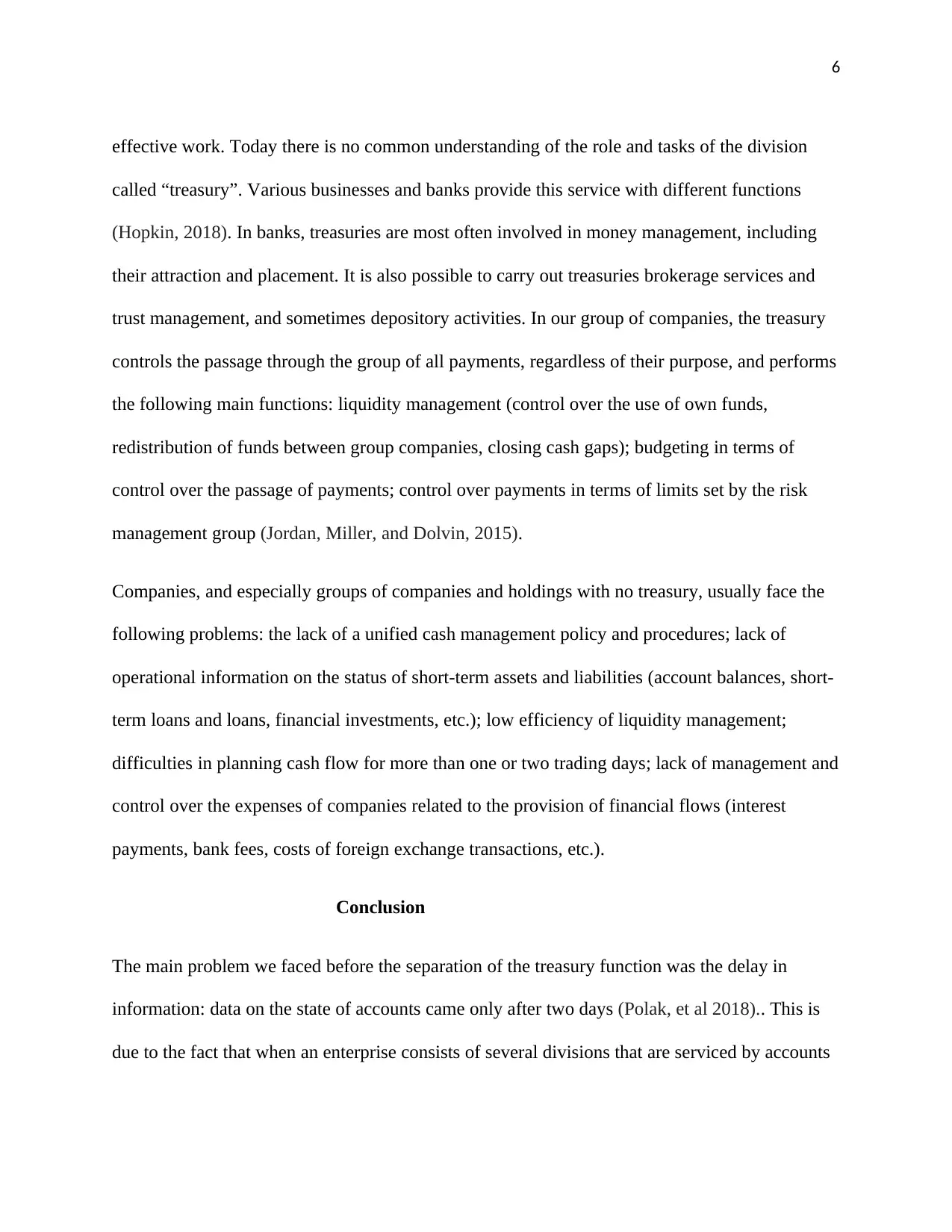
6
effective work. Today there is no common understanding of the role and tasks of the division
called “treasury”. Various businesses and banks provide this service with different functions
(Hopkin, 2018). In banks, treasuries are most often involved in money management, including
their attraction and placement. It is also possible to carry out treasuries brokerage services and
trust management, and sometimes depository activities. In our group of companies, the treasury
controls the passage through the group of all payments, regardless of their purpose, and performs
the following main functions: liquidity management (control over the use of own funds,
redistribution of funds between group companies, closing cash gaps); budgeting in terms of
control over the passage of payments; control over payments in terms of limits set by the risk
management group (Jordan, Miller, and Dolvin, 2015).
Companies, and especially groups of companies and holdings with no treasury, usually face the
following problems: the lack of a unified cash management policy and procedures; lack of
operational information on the status of short-term assets and liabilities (account balances, short-
term loans and loans, financial investments, etc.); low efficiency of liquidity management;
difficulties in planning cash flow for more than one or two trading days; lack of management and
control over the expenses of companies related to the provision of financial flows (interest
payments, bank fees, costs of foreign exchange transactions, etc.).
Conclusion
The main problem we faced before the separation of the treasury function was the delay in
information: data on the state of accounts came only after two days (Polak, et al 2018).. This is
due to the fact that when an enterprise consists of several divisions that are serviced by accounts
effective work. Today there is no common understanding of the role and tasks of the division
called “treasury”. Various businesses and banks provide this service with different functions
(Hopkin, 2018). In banks, treasuries are most often involved in money management, including
their attraction and placement. It is also possible to carry out treasuries brokerage services and
trust management, and sometimes depository activities. In our group of companies, the treasury
controls the passage through the group of all payments, regardless of their purpose, and performs
the following main functions: liquidity management (control over the use of own funds,
redistribution of funds between group companies, closing cash gaps); budgeting in terms of
control over the passage of payments; control over payments in terms of limits set by the risk
management group (Jordan, Miller, and Dolvin, 2015).
Companies, and especially groups of companies and holdings with no treasury, usually face the
following problems: the lack of a unified cash management policy and procedures; lack of
operational information on the status of short-term assets and liabilities (account balances, short-
term loans and loans, financial investments, etc.); low efficiency of liquidity management;
difficulties in planning cash flow for more than one or two trading days; lack of management and
control over the expenses of companies related to the provision of financial flows (interest
payments, bank fees, costs of foreign exchange transactions, etc.).
Conclusion
The main problem we faced before the separation of the treasury function was the delay in
information: data on the state of accounts came only after two days (Polak, et al 2018).. This is
due to the fact that when an enterprise consists of several divisions that are serviced by accounts
⊘ This is a preview!⊘
Do you want full access?
Subscribe today to unlock all pages.

Trusted by 1+ million students worldwide
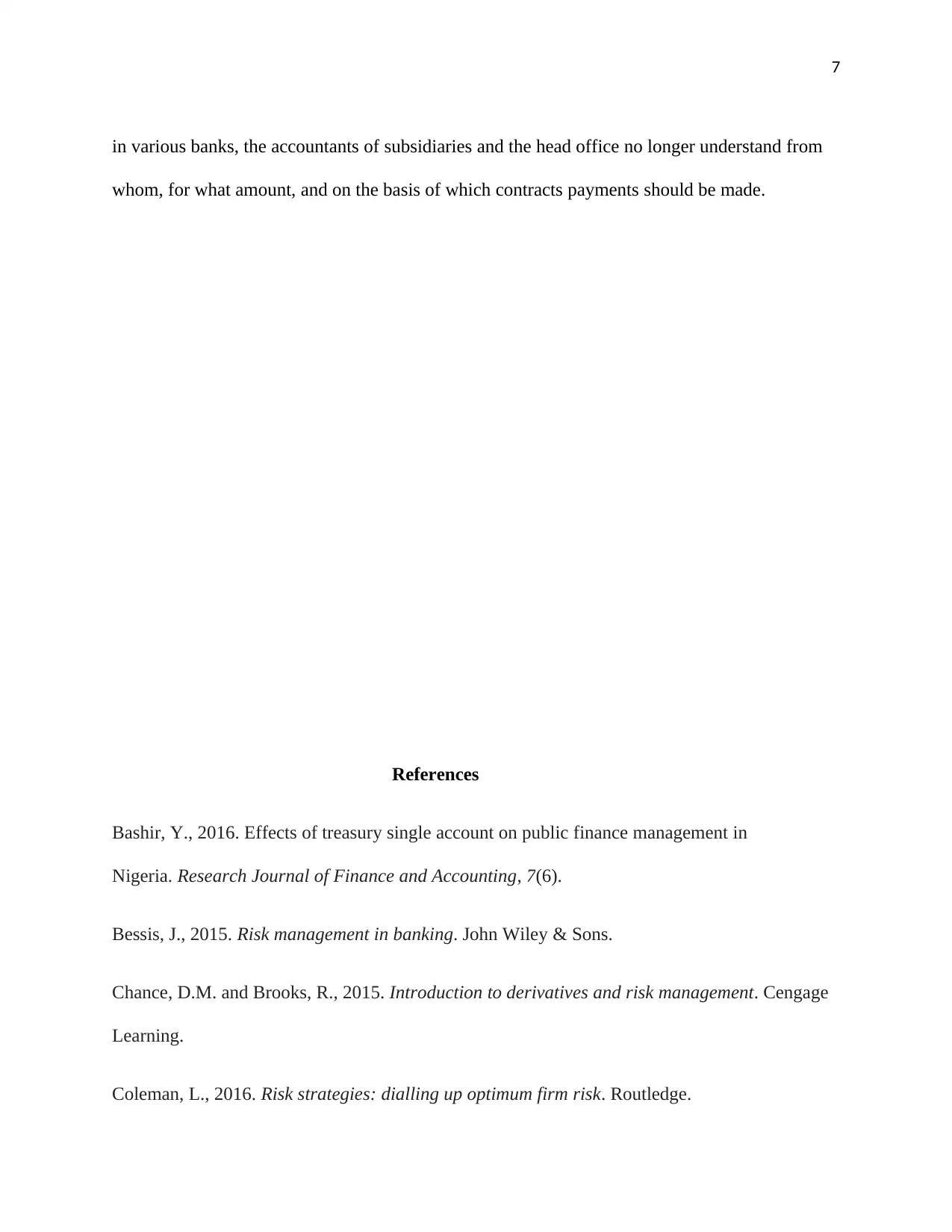
7
in various banks, the accountants of subsidiaries and the head office no longer understand from
whom, for what amount, and on the basis of which contracts payments should be made.
References
Bashir, Y., 2016. Effects of treasury single account on public finance management in
Nigeria. Research Journal of Finance and Accounting, 7(6).
Bessis, J., 2015. Risk management in banking. John Wiley & Sons.
Chance, D.M. and Brooks, R., 2015. Introduction to derivatives and risk management. Cengage
Learning.
Coleman, L., 2016. Risk strategies: dialling up optimum firm risk. Routledge.
in various banks, the accountants of subsidiaries and the head office no longer understand from
whom, for what amount, and on the basis of which contracts payments should be made.
References
Bashir, Y., 2016. Effects of treasury single account on public finance management in
Nigeria. Research Journal of Finance and Accounting, 7(6).
Bessis, J., 2015. Risk management in banking. John Wiley & Sons.
Chance, D.M. and Brooks, R., 2015. Introduction to derivatives and risk management. Cengage
Learning.
Coleman, L., 2016. Risk strategies: dialling up optimum firm risk. Routledge.
Paraphrase This Document
Need a fresh take? Get an instant paraphrase of this document with our AI Paraphraser
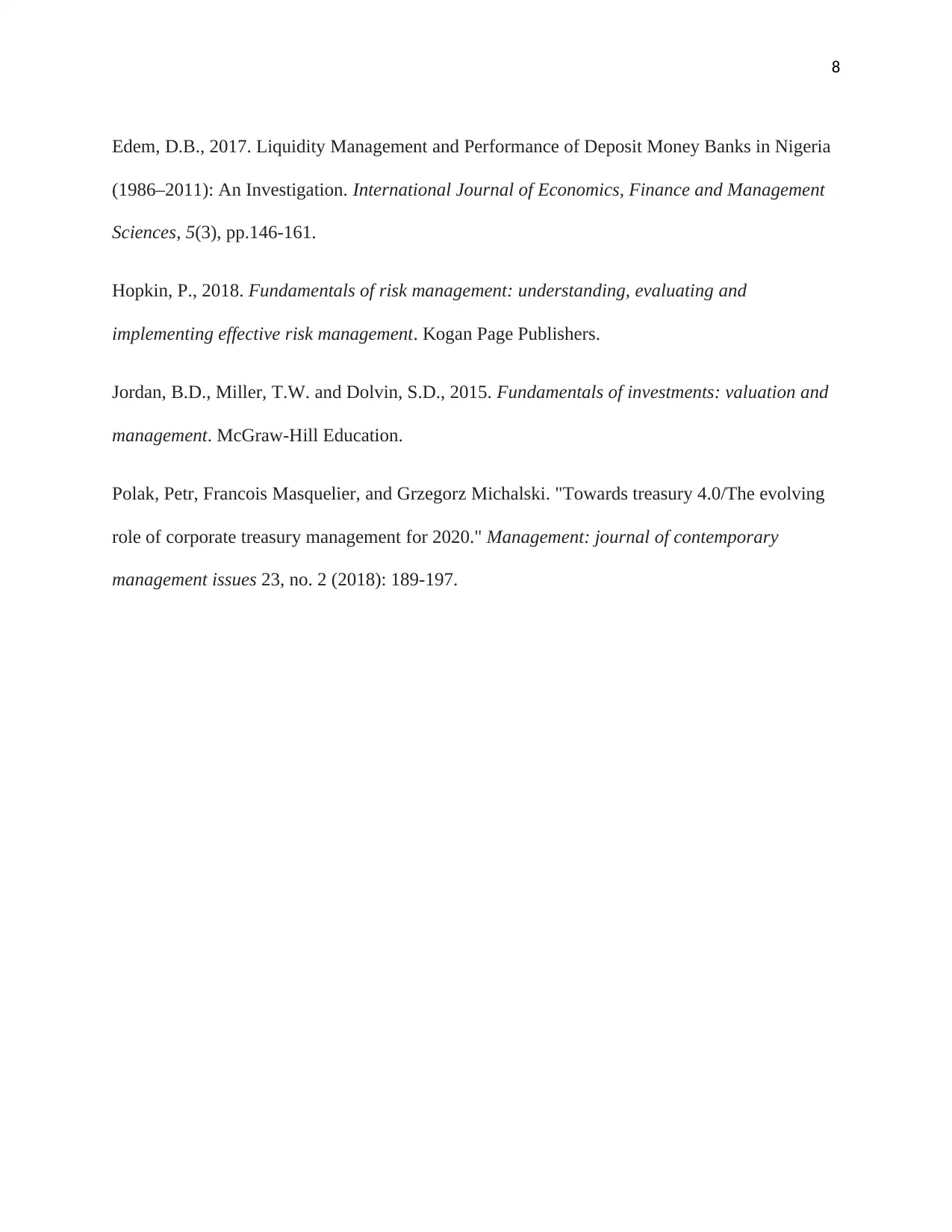
8
Edem, D.B., 2017. Liquidity Management and Performance of Deposit Money Banks in Nigeria
(1986–2011): An Investigation. International Journal of Economics, Finance and Management
Sciences, 5(3), pp.146-161.
Hopkin, P., 2018. Fundamentals of risk management: understanding, evaluating and
implementing effective risk management. Kogan Page Publishers.
Jordan, B.D., Miller, T.W. and Dolvin, S.D., 2015. Fundamentals of investments: valuation and
management. McGraw-Hill Education.
Polak, Petr, Francois Masquelier, and Grzegorz Michalski. "Towards treasury 4.0/The evolving
role of corporate treasury management for 2020." Management: journal of contemporary
management issues 23, no. 2 (2018): 189-197.
Edem, D.B., 2017. Liquidity Management and Performance of Deposit Money Banks in Nigeria
(1986–2011): An Investigation. International Journal of Economics, Finance and Management
Sciences, 5(3), pp.146-161.
Hopkin, P., 2018. Fundamentals of risk management: understanding, evaluating and
implementing effective risk management. Kogan Page Publishers.
Jordan, B.D., Miller, T.W. and Dolvin, S.D., 2015. Fundamentals of investments: valuation and
management. McGraw-Hill Education.
Polak, Petr, Francois Masquelier, and Grzegorz Michalski. "Towards treasury 4.0/The evolving
role of corporate treasury management for 2020." Management: journal of contemporary
management issues 23, no. 2 (2018): 189-197.
1 out of 8
Related Documents
Your All-in-One AI-Powered Toolkit for Academic Success.
+13062052269
info@desklib.com
Available 24*7 on WhatsApp / Email
![[object Object]](/_next/static/media/star-bottom.7253800d.svg)
Unlock your academic potential
Copyright © 2020–2025 A2Z Services. All Rights Reserved. Developed and managed by ZUCOL.





